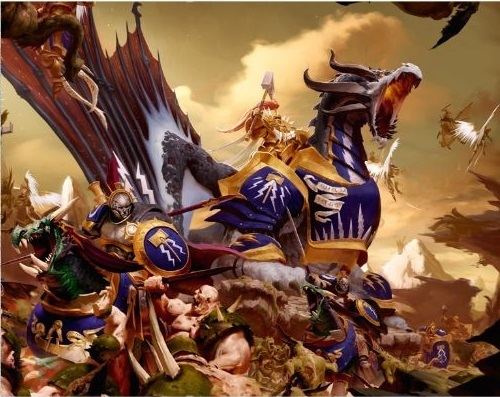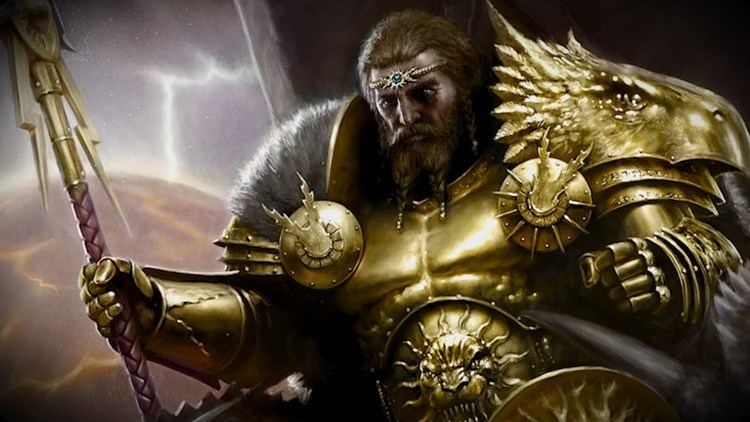 | ||
Similar Von Carstein, Grimgor Ironhide, Dark elves in fiction, Goblin, Terminator | ||
Sigmar Heldenhammer is a fictional deity in the Warhammer Fantasy setting. He is the patron deity of The Empire. Before he became a god, Sigmar was a man, albeit an exceptional, perhaps even superhuman one. The young chieftain of the Unberogens who lived 2,500 years before the present day of the Warhammer universe, he united the barbarian human tribes into what would become the mightiest human nation – the Empire. His sign is a twin-tailed comet or a war hammer.
Contents
- Warhammer age of sigmar official trailer
- History
- Head of Cult of Sigmar
- Sigmarite iconography
- References

Sigmar appears to be inspired by a series of heroes from myth, fantasy literature, especially Robert E. Howard's Conan the Cimmerian, as well as historical figures, particularly Charlemagne and Charles Martel. An image of a hammer-wielding barbarian appeared on early versions of Warhammer Fantasy Battle fighting Orcs and Goblins.
Warhammer age of sigmar official trailer
History
The Imperial Calendar (the calendar now used by the Empire Sigmar founded) takes as its starting date his coronation as Emperor by the high priest of Ulric after having united the tribes under his leadership. This calendar places his birth in the year −30, in the Reikland area in the southwest of the Empire, to the Unberogen tribe (one of the most powerful pre-Empire tribes). The night of his birth was marked with the appearance of a twin-tailed comet, which the human tribes took as a sign of great portent from the gods.
In the year −15, Sigmar is believed to have helped drive off a Goblin invasion of his village – showing exceptional martial powers for a boy of only 15. In the same year, Sigmar led a punitive expedition against an Orc war-party that was holding Kurgan Ironbeard, a king of the Dwarf people, prisoner. In gratitude, Kurgan presented the boy warrior with a magical rune-enchanted war hammer called "Ghal-Maraz" ('Skull-splitter,' in the Khazalid [Dwarven] tongue). Sigmar then went on a campaign to unite the disparate tribes of the future Empire, and one by one they submitted, either by conquest or diplomacy. The most famous incident was his subjugation of the belligerent Teutogens, the largest and most powerful of the tribes, who lived near the Middle Mountains in the north central Empire, near the current location of the Middenheim City-State (Freistadt). Their chieftain, Artur, was defeated by Sigmar in single combat, and this is commonly held to have been the point at which Sigmar gained control of the tribes of the Empire.
From that point onward, Sigmar embarked upon a campaign of purgation and liberation throughout all of the tribal lands, primarily against the Beastmen (Beasts of Chaos) and Goblinoid races (Orcs and Goblins), culminating in the First Battle of Black Fire Pass (IC −1), in present-day Averland, in the southeast of the Empire. Following this great victory, Sigmar returned in triumph to his native Reikland and was crowned Emperor Sigmar Heldenhammer I ('Hammer of Heroes') at Reikdorf, the site of the current Imperial capital of Altdorf. This date remains the Empire's greatest holy day, as it marks Sigmar's coronation and abdication fifty years later (IC 50) – it is in the summer of the Imperial year, on the 18th day of the month of Sigmarzeit.
While an Emperor rules to this day, Sigmar also gave power to the leaders of those tribes who had been united (sometimes by force) into his Empire. These powerful men were set up as the Elector Counts, a hereditary position second only to the Emperor in power and from whose ranks the Emperor (or on rare occasions Empress) is almost always chosen. As it is well known that the Dwarfs will always remember a favor (or a foe), the High King of the Dwarfs, Kurgan, ordered the commissioning of the Runefangs, by the legendary Dwarf smith Alaric the Mad to be gifted to the Elector Counts. Painstakingly crafted (as is the way of the Dwarfs) these blades were not completed until after Sigmar's ascension to godhood, but when finished, they were presented to the Emperor, whom then divided them amongst the 12 ruling counts as symbols of their power, as well as a token of their eternal friendship with the Dwarfs.
During his reign as Emperor, after the Battle of Black Fire Pass, the ancient lord of the undead, Nagash led a great army of the undead into the nascent Empire, but was defeated and slain by Sigmar at the Battle of the River Reik. According to Mannfred von Carstein, Nagash's defeat at the hands of Sigmar resulted in a curse laid upon all vampires: for their part in Nagash's war, they would forever be driven back against the power of Sigmar. Ever since, faith in Sigmar has been powerful enough to drive off Vampires, similar to how the Christian cross drives back Vampires in our own legends.
Nagash wasn't the only great foe Sigmar bested. Sigmar defeated the Great Enchanter Drachenfels, an evil Liche-like entity that existed in the Old World for fifteen thousand years as mentioned in the Warhammer novels Drachenfels and the omnibus Genevieve Undead by Kim Newman, (writing as Jack Yeovil).
Sigmar's greatest victory however was against the first Everchosen of Chaos, Morkar.
In his fiftieth year of reigning, Sigmar abdicated and set off to see what lay beyond the Worlds Edge Mountains to the east, in a similar fashion to the Dwarf ancestor/warrior deity Grimnir the Fearless, who legendarily strode off into the Chaos Wastes to do battle with the Powers of the Warp.
Sources conflict on the details of what precisely motivated Sigmar to do this; some accounts, including those in the earliest background, claim he set off to return Ghal-Maraz to the Dwarfs, but the famous rune-hammer has traditionally been the weapon of the ruling Emperor and the primary symbol/relic of the Sigmarite cult, founded by Johann Helstrum in IC 73.
Following his disappearance, Sigmar passed over the Worlds Edge Mountain range and no human ever saw him again. Within a generation, he was being venerated as a god. The Cult of Sigmar is now the foremost religion in the Empire and is inextricably intertwined with the political, cultural, and national identity of the Empire and its people. Curiously, while still mortal, Sigmar worshipped the Old World pantheon, and was crowned Emperor by the Ar-Ulric (the high priest of the winter god Ulric). As the priests and worshippers of Sigmar often receive puissant, visible answers to their prayers, this suggests Sigmar has been truly deified, and answers his followers. The cult of Sigmar promises an afterlife of great glory for the righteous: after death they will join Sigmar to aid his eternal struggle against Chaos.
Unsurprisingly, the cults of Sigmar and Ulric frequently come into conflict. The Ar-Ulric and the two Arch-Lectors of the Sigmarite faith, as well as the Grand Theogonist (currently Volkmar the Grim), all maintain a vote in the election of the Emperors. While the cult and its leaders are often corrupt and hip-deep in the Byzantine politics of the Empire, it is a faith that preaches courage, justice, honor, and the protection of the weak and innocent from evil. It is also nationalistic and sees the preservation of Sigmar's original holdings as a sacred duty. The church's iconography primarily centres around images directly connected to Sigmar himself: the comet and the hammer are the foremost of these. Also a popular national and religious symbol is the griffon, the personal heraldry of Emperor Magnus the Pious, who saved the Empire from disaster during the Great War Against Chaos in IC 2302–2303.
It is a well-known theory among the theologians the Old World that a Champion of Light arises to do battle with the forces of Chaos when they unify around their periodic leaders. Many have felt that Sigmar may have been one of these, and that he fought the very first Everchosen, Morkar, and a number have argued for Magnus the Pious as well. The most recent case came in the year IC 2522, under a young man named Valten of Lachenbad, who became the central figure around which the Empire rallied to fight Archaon the Everchosen in the recent Storm of Chaos event. Valten was especially noted for his incredible strength, instinctive leadership, and strength of will. Furthermore, he strongly resembled the appearance ascribed to Sigmar in Imperial legend, and sported a birthmark on his chest of Sigmar's legendary twin-tailed comet. Hailed as the 'spiritual leader of the Empire' by Emperor Karl Franz and presented with Sigmar's own hammer Ghal Maraz, Valten was believed by many to be an avatar of Sigmar. He was assassinated shortly after the war with Archaon ended by an assassin of the Skaven Clan Eshin, as was confirmed in the background book, The Loathsome Ratmen and All Their Vile Kin.
Head of Cult of Sigmar
The High Priest of the Cult of Sigmar, called the Grand Theogonist, is an Elector of the Empire. The official base of the Grand Theogonist is the capital of the Empire. Below him in the hierarchy are the two Arch-Lectors, who are also Electors. They are based in the two other largest cities of the Empire. In 2522 IC, the capital is Altdorf and the two Arch-Lectors are based in Nuln and Talabheim.
Grand Theogonists:
The End Times Timeline:
Storm of Chaos Timeline:
In Storm of Chaos timeline (2004 Warhammer Fantasy Battle campaign) presents the Grand Theogonist situation differently than The End Times timeline (2014 Warhammer Fantasy Battle campaign). Both given above.
Sigmarite iconography
Sigmarite dogma teaches that the purest Sigmarites will be welcomed into Sigmar's domain in the Aethyr, the truly evil will be taken by Chaos, and those in between will be claimed by Mórr. Although yet to be canonised as a saint, Magnus the Pious is revered as 'the Saviour' by commoner and Grand Theogonist alike, and is regarded by most as the greatest Sigmarite who ever lived.
